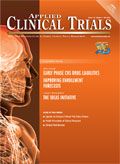Maximizing Oncology Imaging Data
Applied Clinical Trials
Increasing development costs and high failure rates require earlier integration of imaging data in the Phase I setting.
RELATED ARTICLES
A quick search on
http://clinicaltrials.gov/
or "Phase I and oncology" will yield more than 850 ongoing trials. History shows that most of these compounds won't make it past the proof-of-concept stage. But, is that because the focus only has been on determining the dose and safety profile rather than fully defining the mechanism of action?
The utilization of imaging in Phase I studies typically has been to confirm disease progression. While this will determine how long a patient remains on treatment, it may not help answer all the questions regarding the efficacy of the molecule. The only way to improve the success rate coming out of Phase I is to better understand the response the molecule is having leading into Phase II. This will gain in importance as trials evolve to become more adaptive and target specific.
One way to address this situation is to include FDG-PET and DCE-MRI testing as part of the protocol, depending on treatment class and tumor types being examined. While the costs for these tests can add $5,000 to $15,000 per patient depending on the length of time the patient stays on treatment, the cost/benefit can easily be demonstrated. A good example is the use of DCE-MRI to aid with evaluating changes in tumor structure and vasculature to determine if the molecule is impacting tumor response. This data can be utilized to determine the molecule's viability and targeted patient population. Because these imaging assays directly assess the drug's mechanism of action (reduction in blood flow and/or vascular perfusion) they can provide an earlier and clearer picture of the drug's efficacy than downstream markers like change in tumor size or overall survival. Armed with this information, clients gain critical flexibility in their trials and have the potential to realize cost savings through reduced sample sizes and/or shorter trials. Most importantly, such data can provide clients with the knowledge they need to make earlier, more confident go/no-go decisions regarding their compounds.
As with any analysis, the limitations of the imaging results need to be recognized and procedures must be implemented to ensure that no bias is introduced by other circumstances. As such, two key matters need to be addressed to limit this possibility.
Two important factors
The first step is to understand how tumor or metabolic changes may impact results over time and factor that into the analysis. An example is the use of perfusion assessment (DCE-MRI or DCE-CT) to determine if an anti-angiogenic drug is having the desired effect. Typically, a reduction in tumor blood flow and vascular permeability will confirm that the treatment is appropriate. However, a rapidly growing tumor often will outgrow its own vasculature, resulting in the development of internal necrosis and an overall reduction in contrast uptake, mimicking the effects of anti-angiogenic therapy. Since anti-tumor treatment also may have an effect on angiogenesis, the imaging data needs to be considered with all of the clinical and laboratory data included in the decision-making process.
The second factor is related to data quality and the potential for the inconsistent reading of results. While imaging standards now are fairly consistent across the globe, the focus needs to be on ensuring high-quality, reproducible data.
Lessons learned
As more Phase II/III studies are implementing real-time reviews of the imaging data, a couple lessons can be applied in the Phase I space.
Study-specific training should be conducted with the sites to reduce variability in the imaging collection process. Incorporating an imaging vendor into this process can improve the outcome by addressing the technical aspects with the radiology staff and by completing phantom scans at each site to assess consistency.
To reap the benefits of the training, scans must be collected on an ongoing basis to address data quality concerns, if any are identified. While CRAs can review scans to ensure they are complete, they lack the expertise to determine if the specific imaging guidelines were followed. Using an imaging vendor for central analysis will aid in addressing imaging quality from the sites by assessing qualitative and quantitative measures and addressing concerns immediately with sites. Incorporating imaging reviews as part of the ongoing data cleaning efforts, should limit surprises when it comes time to review results.
Conclusion
In summary, today's environment of increasing development costs and high failure rates requires earlier integration of imaging data in the Phase I setting. Using tests that help fill clinical data gaps and implementing steps to ensure quality data is collected on a real-time basis are critical to improving the decision-making process and assuring that a molecule is moving along the right path.
Edward Ashton, PhD, is the Chief Scientific Officer, at VirtualScopics, Inc., 500 Linden Oaks, Rochester, NY, e-mail: [email protected]. Michael Henning is a Project Management Director at PPD, 929 North Front Street, Wilmington, NC, e-mail: [email protected].

Improving Relationships and Diversifying the Site Selection Process
April 17th 2025In this episode of the Applied Clinical Trials Podcast, Liz Beatty, co-founder and chief strategy officer, Inato, discusses a number of topics around site engagement including community-based sites, the role of technology in improving site/sponsor relationships, how increased operational costs are impacting the industry, and more.